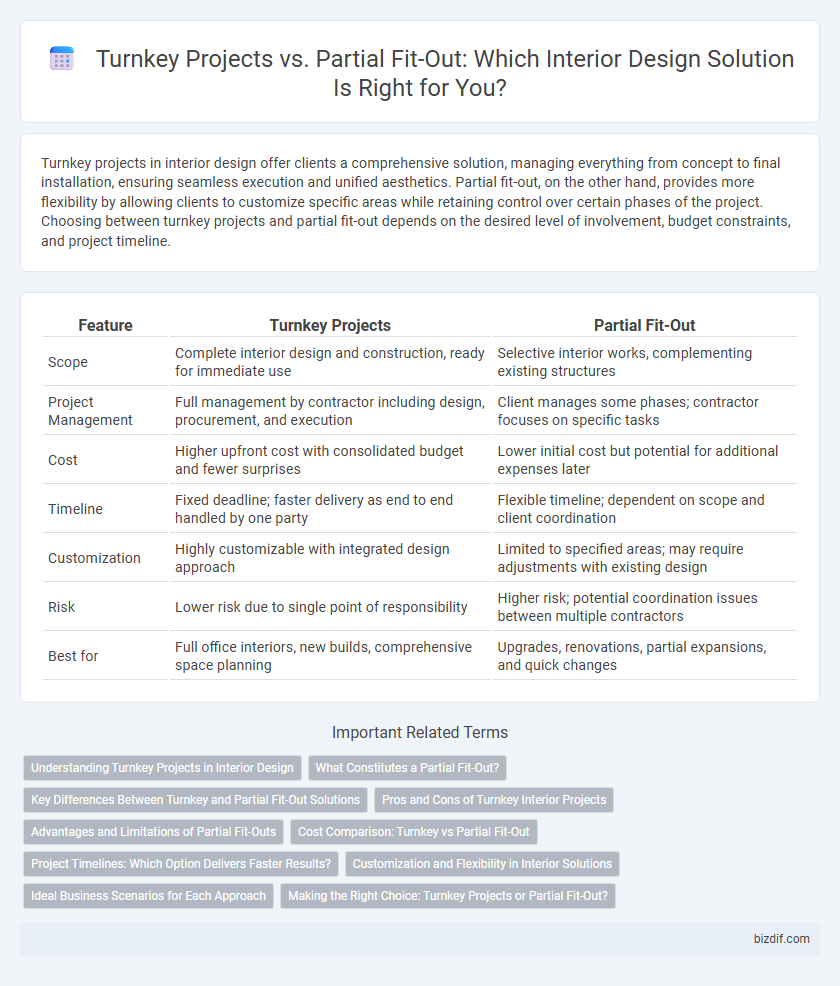Turnkey projects in interior design offer clients a comprehensive solution, managing everything from concept to final installation, ensuring seamless execution and unified aesthetics. Partial fit-out, on the other hand, provides more flexibility by allowing clients to customize specific areas while retaining control over certain phases of the project. Choosing between turnkey projects and partial fit-out depends on the desired level of involvement, budget constraints, and project timeline.
Table of Comparison
| Feature | Turnkey Projects | Partial Fit-Out |
|---|---|---|
| Scope | Complete interior design and construction, ready for immediate use | Selective interior works, complementing existing structures |
| Project Management | Full management by contractor including design, procurement, and execution | Client manages some phases; contractor focuses on specific tasks |
| Cost | Higher upfront cost with consolidated budget and fewer surprises | Lower initial cost but potential for additional expenses later |
| Timeline | Fixed deadline; faster delivery as end to end handled by one party | Flexible timeline; dependent on scope and client coordination |
| Customization | Highly customizable with integrated design approach | Limited to specified areas; may require adjustments with existing design |
| Risk | Lower risk due to single point of responsibility | Higher risk; potential coordination issues between multiple contractors |
| Best for | Full office interiors, new builds, comprehensive space planning | Upgrades, renovations, partial expansions, and quick changes |
Understanding Turnkey Projects in Interior Design
Turnkey projects in interior design offer comprehensive solutions that include everything from initial concept development to final execution, ensuring a seamless handover of a fully finished space. These projects encompass design planning, procurement of materials, construction, and installation, providing clients with a single point of responsibility. This holistic approach minimizes client involvement in day-to-day management and reduces coordination challenges, delivering a complete, ready-to-use interior.
What Constitutes a Partial Fit-Out?
A Partial Fit-Out in interior design involves completing specific sections of a space, such as flooring, ceilings, or lighting, based on the client's existing infrastructure. Unlike Turnkey Projects that cover end-to-end design and construction, Partial Fit-Out focuses on upgrading or customizing particular elements without a full overhaul. This approach allows for targeted improvements while leveraging the existing architectural and mechanical systems.
Key Differences Between Turnkey and Partial Fit-Out Solutions
Turnkey projects provide a comprehensive interior design solution, handling everything from concept and planning to execution and final handover, ensuring a fully functional space ready for use. Partial fit-out services focus only on specific elements such as flooring, partitions, or ceilings, leaving key areas like HVAC, electrical, or plumbing to be completed by the client or other contractors. The main difference lies in project scope and responsibility, with turnkey delivering complete end-to-end management, while partial fit-out offers customized finishes within an existing shell.
Pros and Cons of Turnkey Interior Projects
Turnkey interior projects offer a streamlined approach where the client receives a fully completed space, minimizing coordination efforts and ensuring consistent design execution. This method reduces project timelines and risk by involving a single contractor responsible for all phases, but it can limit customization flexibility and potentially increase upfront costs. Clients benefit from predictable outcomes and simplified communication, though they may face less control over specific design elements compared to partial fit-outs.
Advantages and Limitations of Partial Fit-Outs
Partial fit-outs offer greater flexibility by allowing clients to customize specific areas while controlling budget constraints, making them ideal for phased space development or tenant improvement projects. Limitations include potential inconsistencies in design cohesion and increased coordination efforts between existing infrastructure and new installations. This approach often results in faster project completion but may require additional future modifications as business needs evolve.
Cost Comparison: Turnkey vs Partial Fit-Out
Turnkey projects typically involve a higher upfront cost due to comprehensive services that cover design, construction, and final finishes, providing a seamless, all-inclusive solution. Partial fit-out projects often incur lower initial expenses, focusing only on essential installations and allowing clients to customize subsequent phases according to budget constraints. Cost efficiency in partial fit-outs depends on phased implementation, while turnkey solutions guarantee fixed pricing but less flexibility in managing expenditures.
Project Timelines: Which Option Delivers Faster Results?
Turnkey projects typically offer faster completion as they involve end-to-end management, consolidating design, procurement, and construction within a single timeline. Partial fit-out focuses on specific interior elements, often requiring coordination with separate contractors, which can extend project durations. Choosing turnkey solutions minimizes delays by streamlining processes and reducing dependency on multiple vendors, ensuring quicker delivery of finished interiors.
Customization and Flexibility in Interior Solutions
Turnkey projects offer fully customized interior design solutions delivered as a complete package, minimizing client involvement while ensuring cohesive aesthetics and functionality. Partial fit-out allows greater flexibility by enabling clients to selectively customize specific areas or elements, accommodating evolving needs and budget constraints. Choosing between turnkey and partial fit-out depends on desired control over design details and timeline requirements.
Ideal Business Scenarios for Each Approach
Turnkey projects suit businesses seeking complete interior design solutions with minimal management, ideal for startups or companies expanding quickly requiring fully operational spaces upon handover. Partial fit-out is optimal for established businesses aiming to customize specific areas while retaining control over other elements, often chosen by companies with existing infrastructure or phased expansion plans. Choosing between turnkey and partial fit-out depends on budget, timeline, and the desired level of involvement in the design and construction process.
Making the Right Choice: Turnkey Projects or Partial Fit-Out?
Choosing between turnkey projects and partial fit-out depends on the scope, budget, and timeline of your interior design needs. Turnkey projects offer a comprehensive solution, managing everything from design to completion for seamless delivery, ideal for clients seeking a hassle-free experience. Partial fit-out allows more customization and flexibility by focusing on specific areas, making it suitable for businesses with existing infrastructure or budget constraints.
Turnkey Projects vs Partial Fit-Out Infographic

 bizdif.com
bizdif.com